The Monuments. Cycling’s five most historic one-day races, whose legendary editions roll off the tongue like oil down a chain. The 2011 Tour of Flanders. 2021’s Paris-Roubaix. Arguably, this season’s Milan-San Remo.
Certain names are equally synonymous — Eddy Merckx, Tom Boonen, Fabian Cancellara, Sean Kelly, Johan Museeuw. After this season, it is time to add Tadej Pogacar to the list.
Already the greatest Grand Tour rider of his generation — and possibly the best of all-time — the 27-year-old Slovenian took his one-day racing to the next level in 2025. Appearing to enjoy the Classics over any other race, he became just the second rider, after Merckx, to win three Monuments in one year — and was the first ever rider to finish on the podium at all five Monuments.
It has been a historic year — this is the story of the 2025 Monuments in 20 pictures.
Milan-Sanremo, March 21
Mathieu van der Poel (Alpecin-Deceuninck) 6:22:53
Filippo Ganna (INEOS Grenadiers) same time
Tadej Pogacar (UAE Team Emirates) same time

Milan-San Remo is one of very few races that Pogacar is yet to tame (MARCO BERTORELLO/AFP via Getty Images)
Milan-Sanremo is a unique course. Largely flat, it gets lumpy towards the end and the final two iconic climbs — the Cipressa and the Poggio — usually get rid of the sprinters, yet neither ascent is hard enough for the race to suit the pure climbers. Throw in the final terrifying descent of the Poggio, and the flat run-in to the finish, and it is clear to see why Milan-Sanremo is arguably the most unpredictable Monument of them all.

The peloton make their way down the coast to Sanremo (MARCO BERTORELLO/AFP via Getty Images)
Often affected by extreme weather due to its position at the beginning of the season, 2025’s edition was raced on a day that started in the rain but ended in sunshine. By far the longest Monument at almost 300km, no man has won it twice in a row since Erik Zabel in 2000 and 2001. For once, Pogacar’s success would be down to an element of chance.
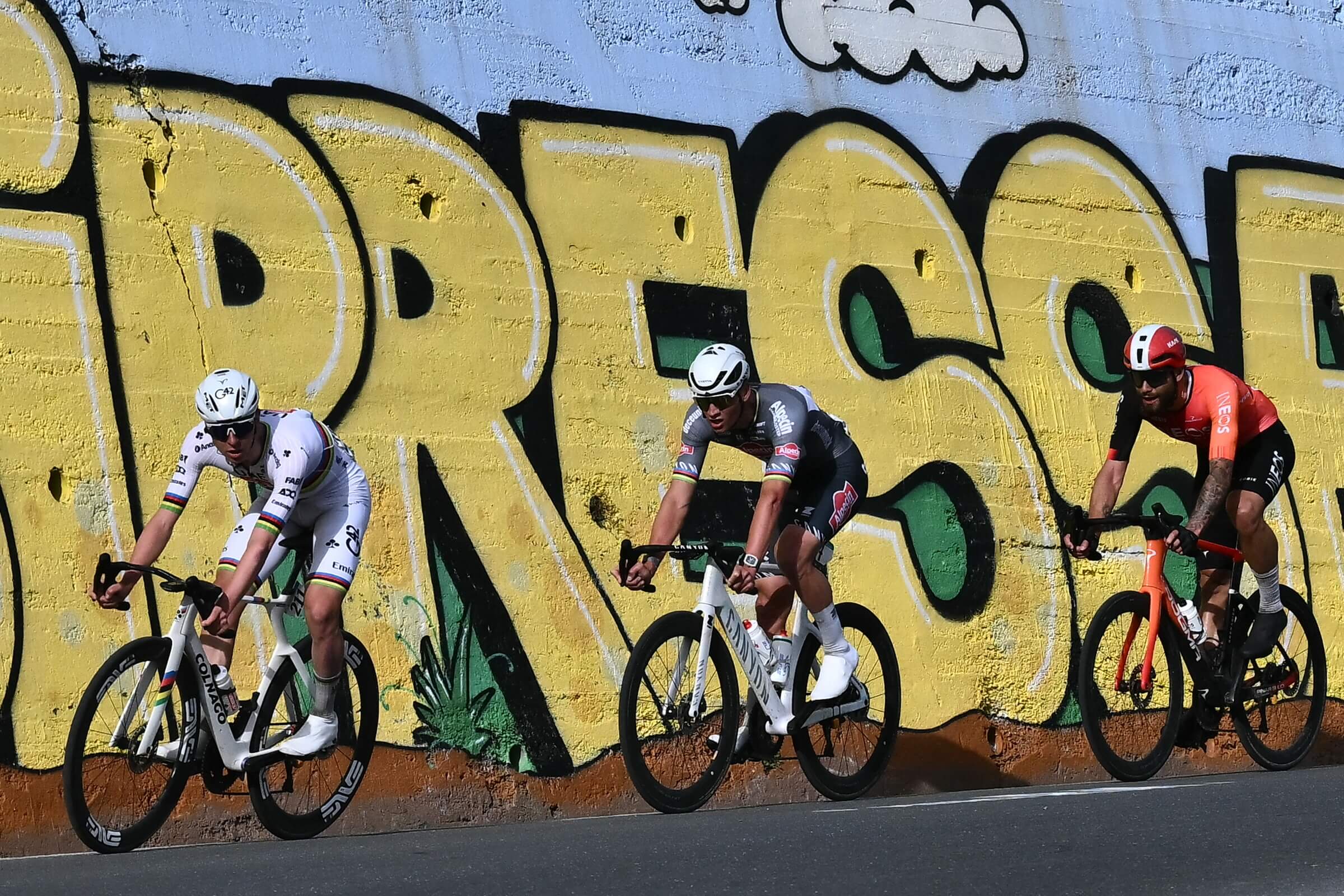
The eventual top three altogether as they prepare to descend the Cipressa (MARCO BERTORELLO/AFP via Getty Images)
Pogacar attacked on the Cipressa, 25km from home, and was joined by home rider Filippo Ganna, and Dutchman Mathieu van der Poel. Having won six Monuments entering this season, Van der Poel is arguably Pogacar’s only true rival in the Classics.
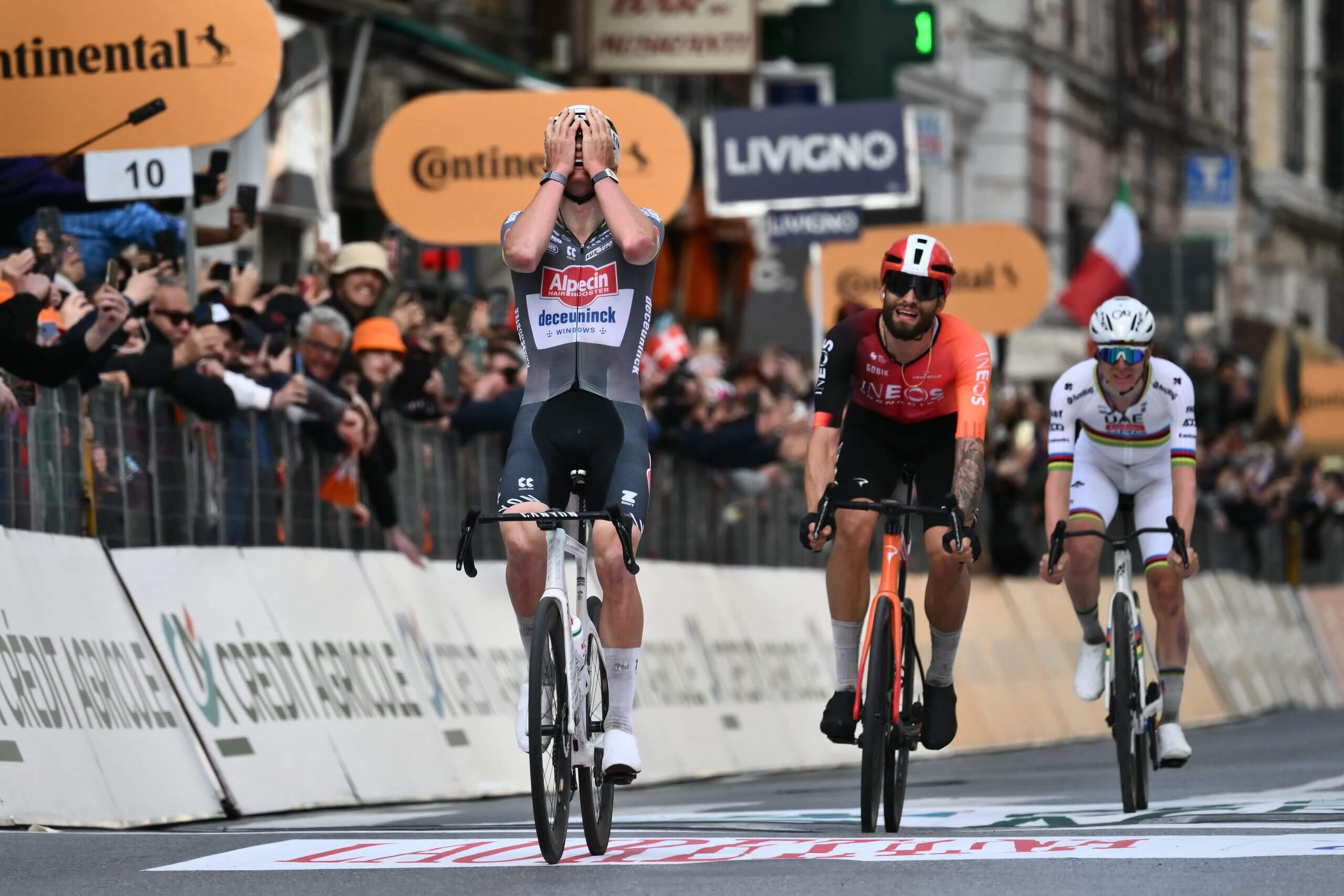
Van der Poel covers his face as he wins in Sanremo for the second time in three editions (MARCO BERTORELLO/AFP via Getty Images)
Though Pogacar attacked again up the Poggio, Van der Poel impressively remained with him despite their weight differential. When time-trial specialist Ganna bridged over once more on the descent, the three raced together towards the line — with Van der Poel powering clear in the sprint. Incredibly, third place would be Pogacar’s lowest finish in a Monument in 2025.
Ronde van Vlaanderen, April 6
Tadej Pogacar (UAE Team-Emirates) 5:58:41
Mads Pedersen (Lidl-Trek) +1m 1s
Mathieu van der Poel (Alpecin-Deceuninck) same time

The Tour of Flanders is a day for regional pride in this part of Belgium (Dario Belingheri/Getty Images)
France may host the sport’s most high-profile race, but if cycling has a spiritual home, its postcode is probably on the cobbles of Flanders. “As a Belgian, winning Flanders for the first time is far more important than wearing the maillot jaune in the Tour,” said three-time winner Johan Museeuw of the Tour of Flanders (Ronde van Vlaanderen).
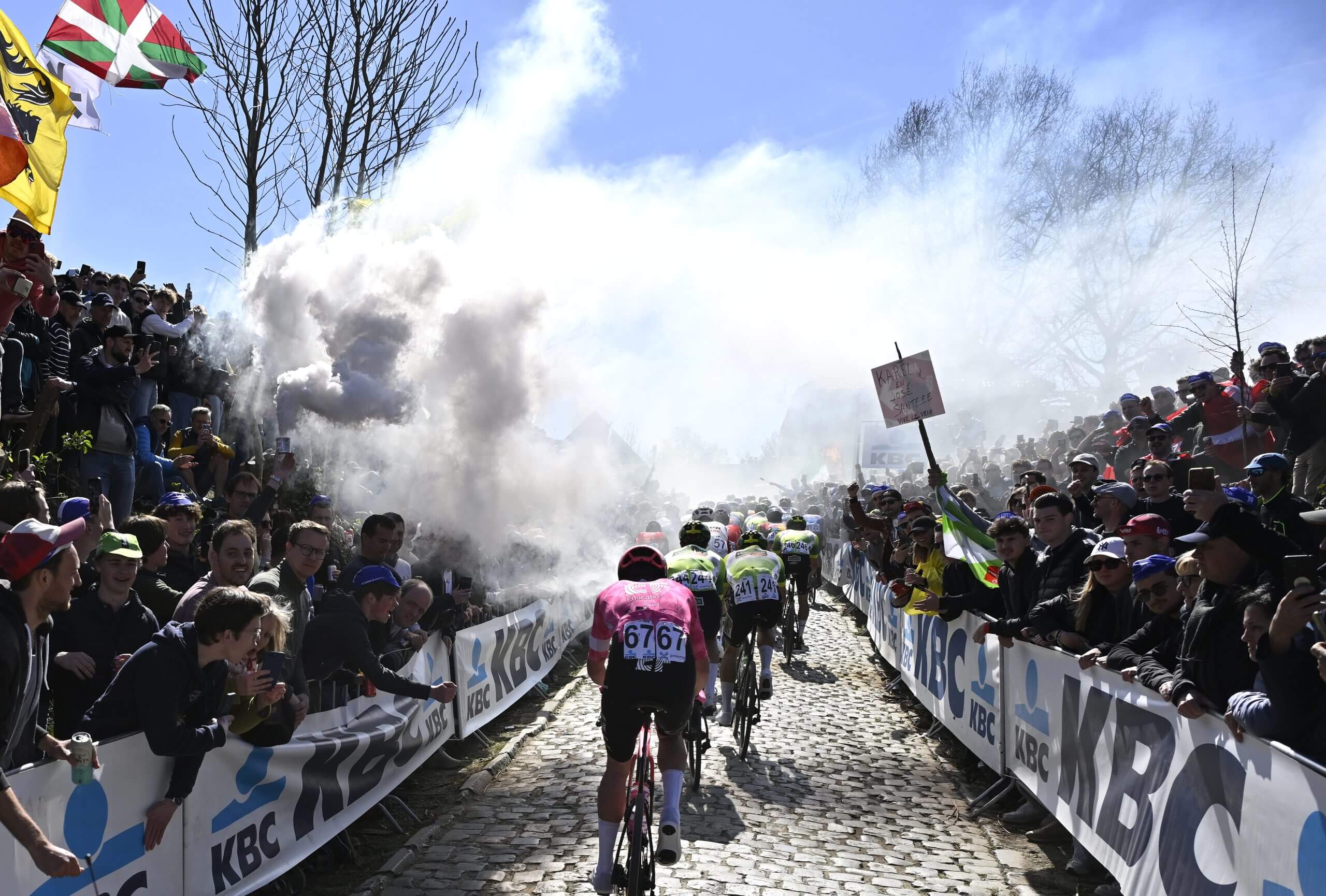
Three ascents of the Oude Kwaremont make it one of the best places to watch the race (Jan de Meulenier – Pool/Getty Images)
The Tour of Flanders is attritional, suiting rouleurs that can climb — Pogacar and Van der Poel were favourites once again, having won four of the five previous editions between them. Featuring 2200m of cobbled climbing in front of raucous fans, the Oude Kwaremont is a key tactical location, and where Pogacar had gone clear to win in 2023.
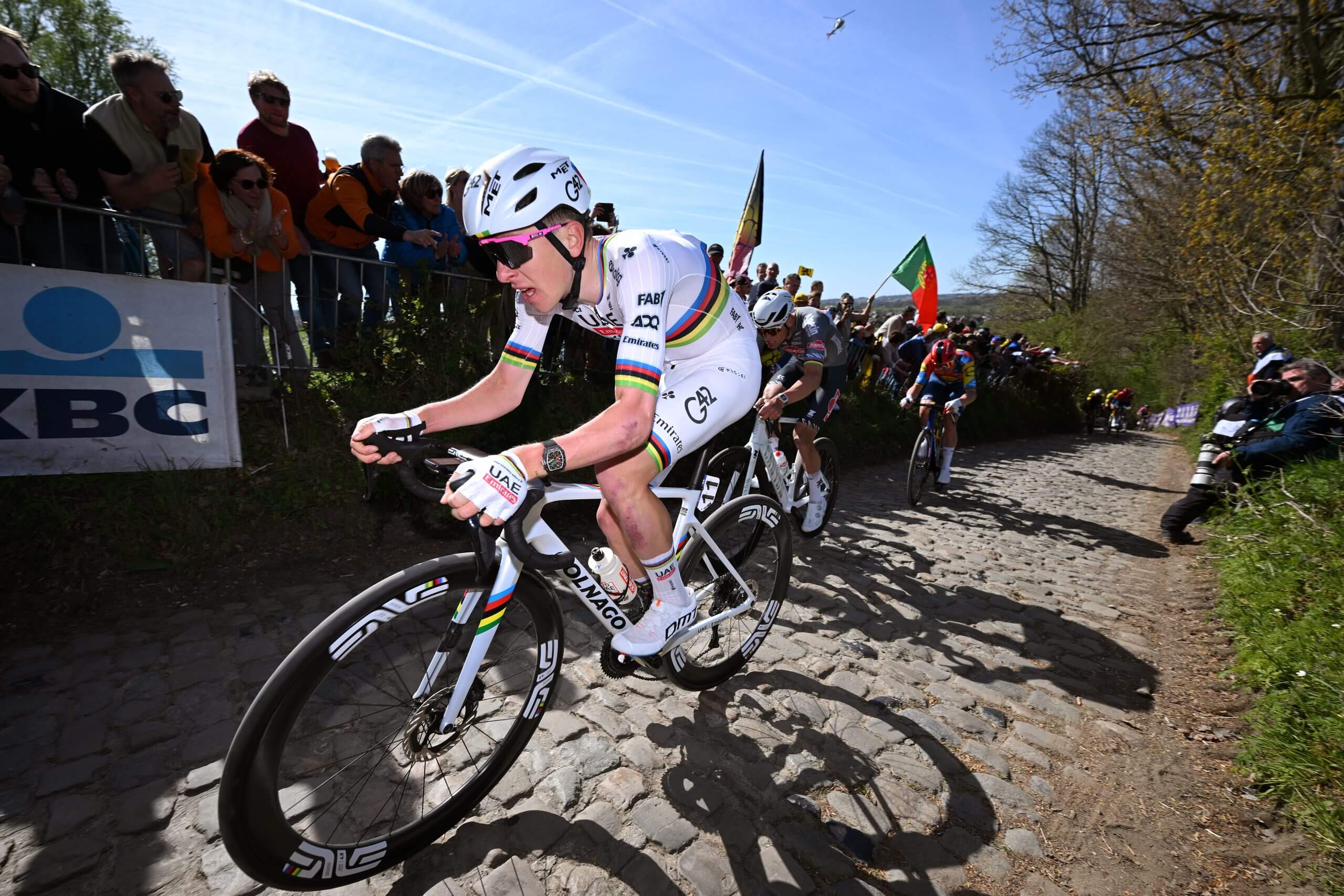
Pogacar attacks up the Koppenberg, with Van der Poel and Pedersen straining to keep up (Dario Belingheri/Getty Images)
This is the pavé section of the Monuments season, with its climbing requiring far more pure power. Pogacar produced a remarkable estimated 9.07 watts/kg on the infamous Koppenberg for just over one minute to all but crack Pedersen and Van der Poel, going decisively clear on the following ascent of the Oude Kwaremont.
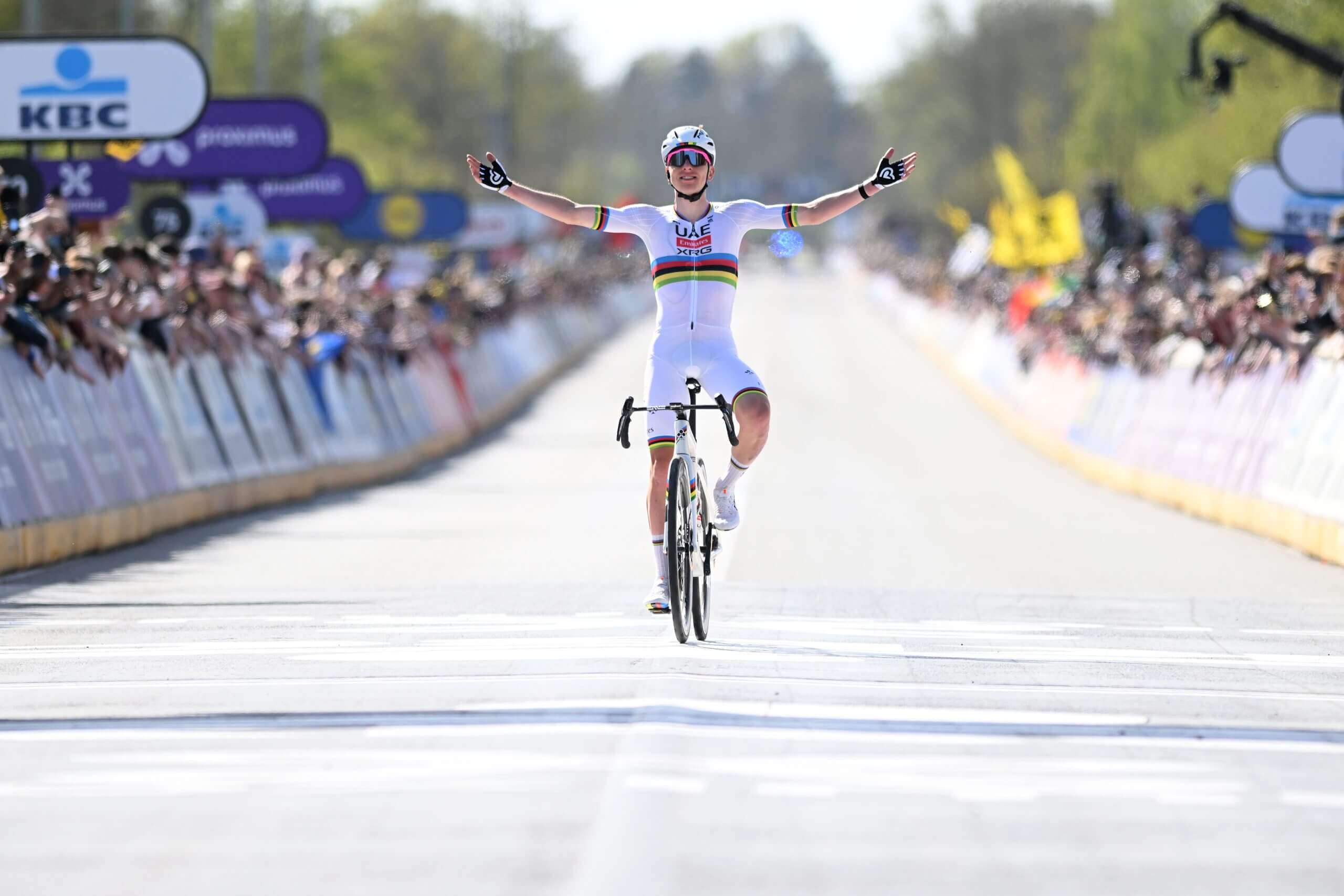
Pogacar celebrates yet another solo victory (Dario Belingheri/Getty Images)
Pogacar won the Tour of Flanders by over a minute from Lidl-Trek’s Mads Pedersen — but in finishing third, Van der Poel ensured he finished on the podium in this race for a record sixth consecutive year.
Paris-Roubaix, April 13
Mathieu van der Poel (Alpecin-Deceuninck) 5:31:27
Tadej Pogacar (UAE Team Emirates) +1m 18s
Mads Pedersen (Lidl-Trek) +2m 11s
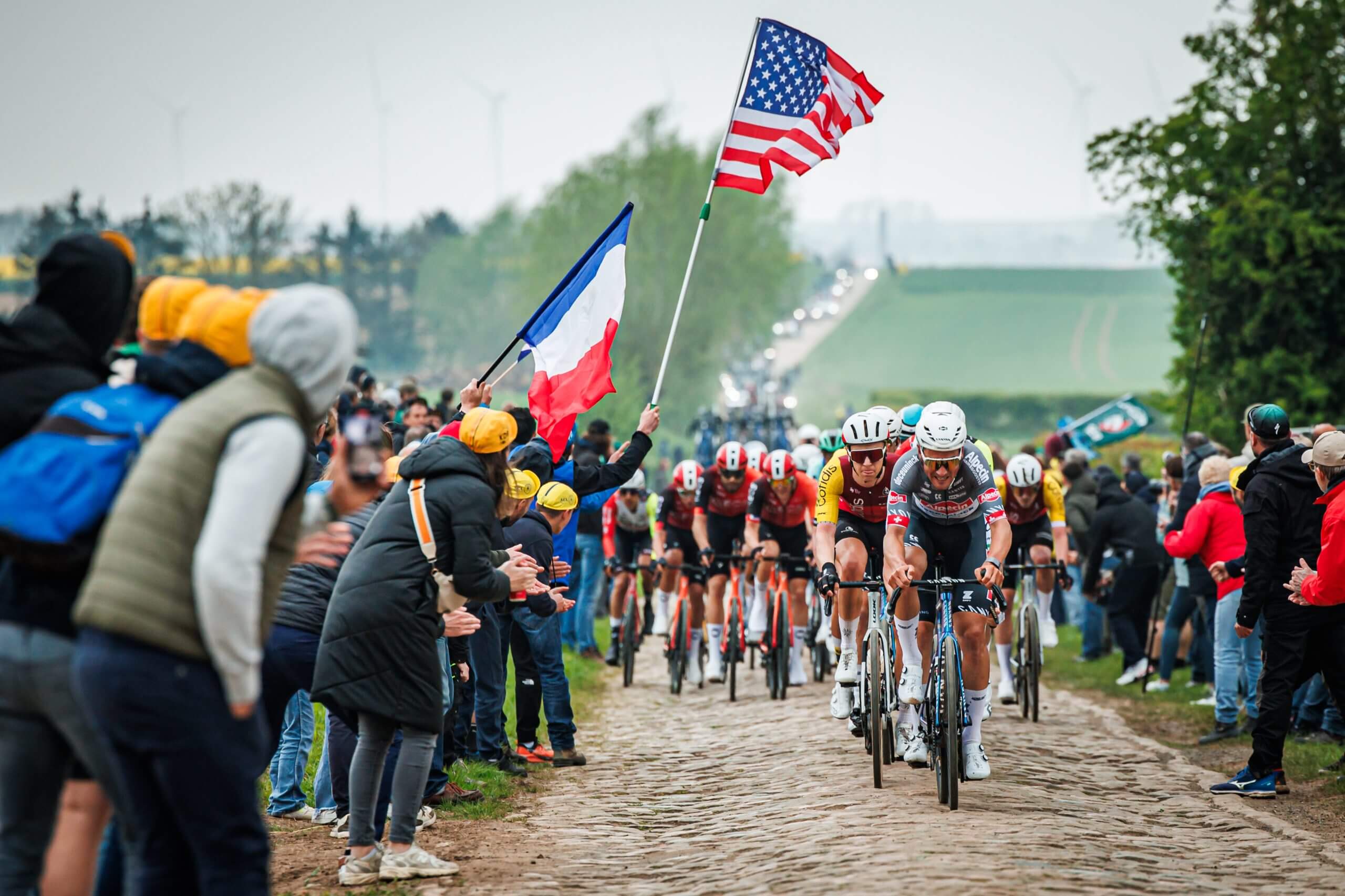
The much-feared cobbles of Paris-Roubaix comprise 55km of the 260km route (Pim Waslander/Soccrates/Getty Images)
Paris-Roubaix was always going to be Pogacar’s toughest challenge. Long and cobbled, the Hell of the North is a test of raw strength, not power-to-weight. Grand Tour winners would ordinarily be too slight to even consider victory — that he was even in contention is why Pogacar is such a special rider.

Van der Poel tames the five-star difficulty Trouée d’Arenberg with relative ease (Billy Ceusters/Getty Images)
The Arenberg Trench is where Paris-Roubaix can be won or lost — the ‘road’ wanting to buck those who ride its cobbles off its back. Teenage British rider Matthew Brennan, who enjoyed a breakout debut season, was particularly impressive here in his first Monument.

Van der Poel has now won Paris-Roubaix three years in a row (Luc Claessen/Getty Images)
Pogacar and Van der Poel were, once again, in the leading group at a Monument with 38km remaining. However, Pogacar crashed on a tight right-hander after a momentary lapse of concentration — and though both required bike changes, Van der Poel remained ahead to win his third successive Paris-Roubaix. He is the first rider to do that since Francesco Moser between 1978 and 1980.
However, the Dutchman was hit by a water bottle thrown by a Belgian fan in the closing kilometres. “It’s not normal. It was a full bottle, it’s maybe half a kilogram and I rode 50kph, it was like a stone hitting my face,” Van der Poel said.

Pogacar sits in the velodrome after finishing second in his first attempt at the race (Dario Belingheri/Getty Images)
Usually, the cobbles of Paris-Roubaix make an attempt far too risky for a potential Tour de France winner to enter. Pogacar’s UAE Team Emirates squad initially banned him from entering — but the Slovenian talked his sporting director Joxean Fernandez Matxin around, wanting the fresh challenge.
Paris-Roubaix, Milan-Sanremo, and the Vuelta a Espana are the only major races missing from Pogacar’s palmares.
Liege-Bastogne-Liege, April 27
Tadej Pogacar (UAE Team Emirates) 6:00:09
Guilio Ciccone (Lidl-Trek) +1m 3s
Ben Healy (EF Education-Easypost) same time

One of the most iconic annual photos in cycling, as the peloton climb the Côte de Saint-Roch (Dario Belingheri/Getty Images)
The most ancient of the Monuments, Liege-Bastogne-Liege is known as La Doyenne — roughly translated as the Old Lady. Held in the French-speaking Belgian region of Wallonia, Bastogne was originally chosen as the turn point so its 19th-century race organisers could hop on a train to staff a midway checkpoint.
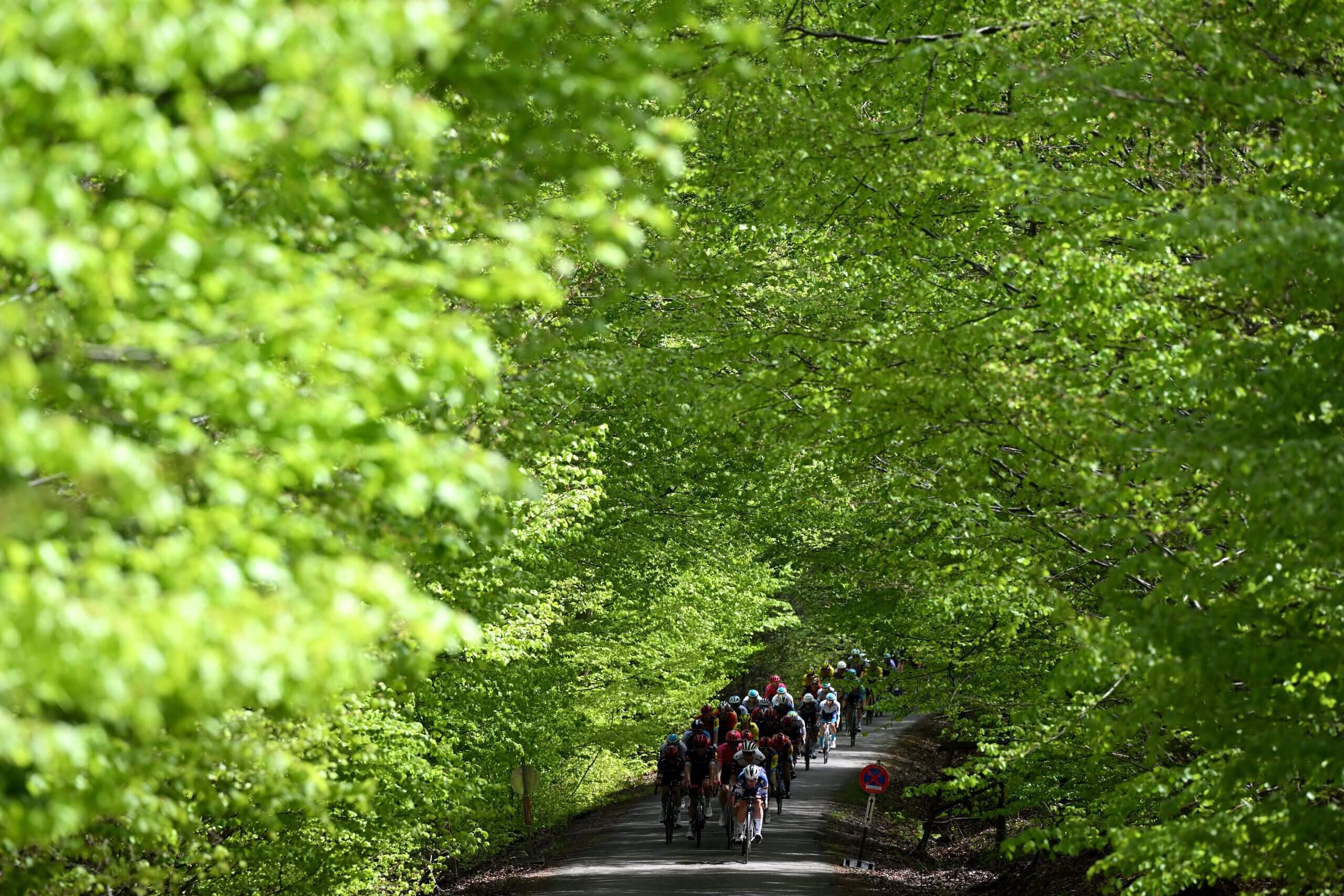
It is not unknown for this race to see snow, but this year’s edition was firmly springlike (Dario Belingheri/Getty Images)
Coming at the end of the Ardennes Classics, a week of races which also includes the prestigious Amstel Gold Race and Fleche Wallone, the peloton would have likely enjoyed momentarily seeing greenery rather than Pogacar’s world champion’s jersey disappearing up the road. He had won Fleche Wallone decisively just four days earlier, having surprisingly been beaten by Mattias Skjelmose at the Amstel Gold Race one week earlier.
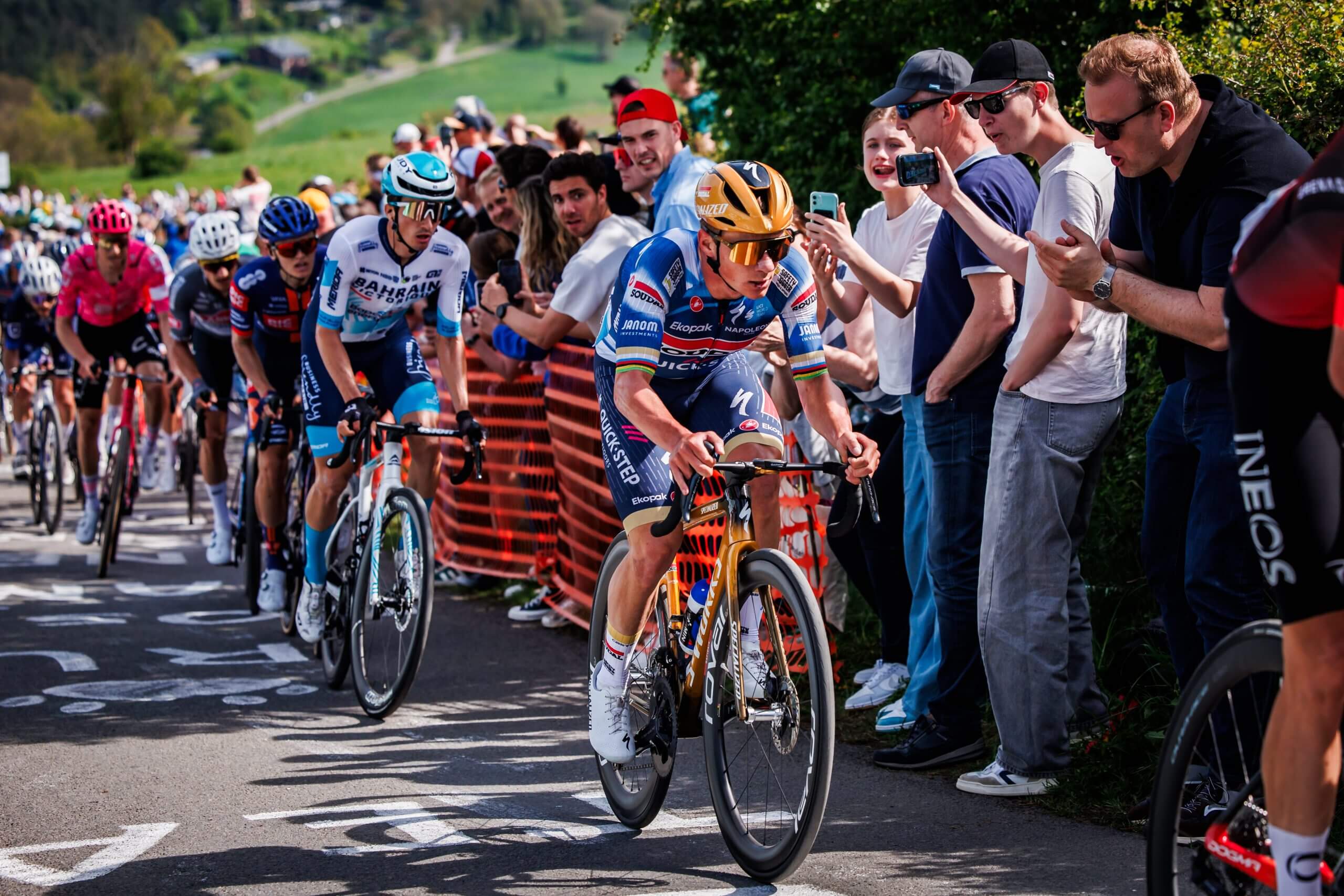
Remco Evenepoel could only finish 59th, as he continued to recover from a serious crash he suffered over the winter (Pim Waslander/Soccrates/Getty Images)
Having crashed into the opening door of a Belgian postal van in early December, Evenepoel’s winter training had been severely disrupted. The Belgian time trial maestro was still suffering from nerve damage in his shoulder when he restarted racing, but a win on his return at Brabantse Pijl raised expectations. However, Liege-Bastogne-Liege, a race he had won twice before, came too soon.
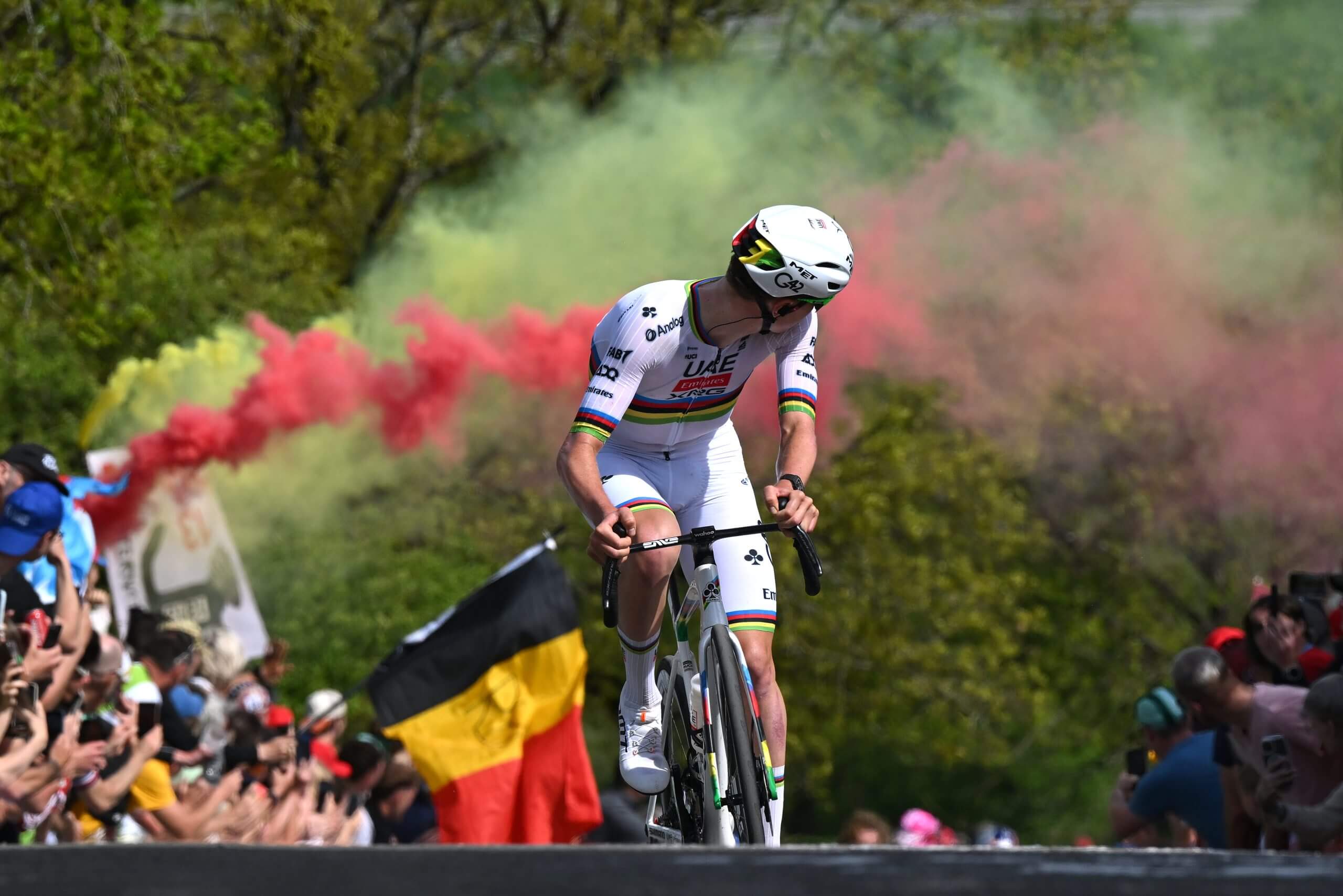
Pogacar looks back as he attacks on the Côte de la Redoute. He would not be seen again by his competitors (Dario Belingheri/Getty Images)
Pogacar’s win at Liege-Bastogne-Liege was his most dominant of the Monument season. Save for a brief sortie from INEOS, the peloton did little of any tactical imagination to prevent his victory, with no rider able to follow him up the Cote de la Redoute — raising questions over whether this passivity was good for cycling.
Il Lombardia, October 11
Tadej Pogacar (UAE Team Emirates) 5:45:53
Remco Evenepoel (Soudal Quick-Step) +1m 48s
Michael Storer (Tudor Pro Cycling) +3m 14s
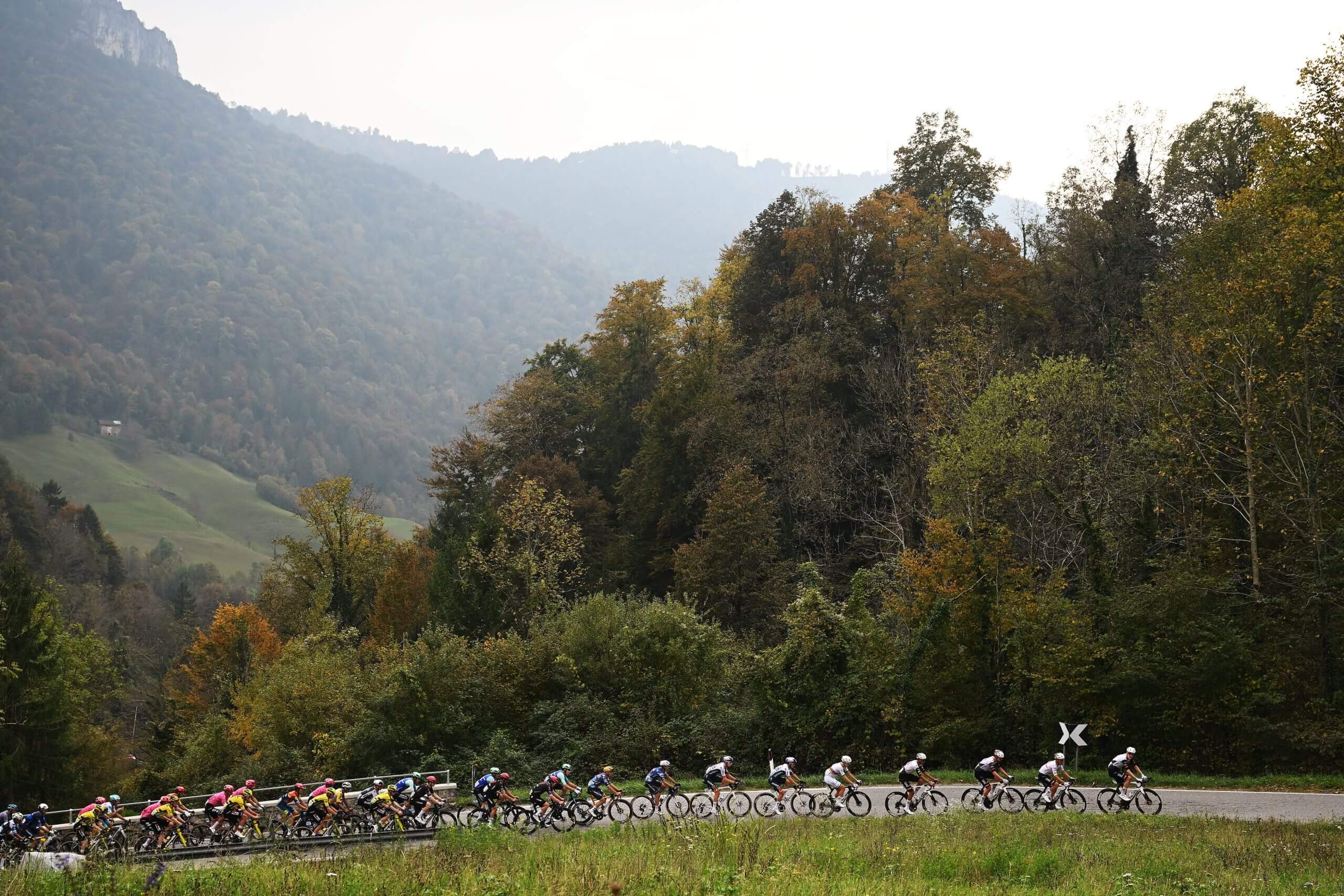
‘The race of the falling leaves’ was still looking fairly green on Saturday (Dario Belingheri/Getty Images)
Il Lombardia is the only Monument to take place after the sport’s three Grand Tours — and the peloton is usually in a wildly different condition to how it started the season.

Pogacar accelerates away from Simmons, shortly after catching the American champion (Dario Belingheri/Getty Images)
For Pogacar, a master of recovery, the race’s position at the end of the season suits him perfectly. Fresh from winning both the world and European titles over the past month, he set out in pursuit of his record fifth consecutive Lombardia — a feat no rider has achieved in any Monument before.

Simmons’ reward for his day on the attack was an impressive fourth place (Sara Cavallini/Getty Images)
Quinn Simmons has had a vastly impressive season, without the results to show for it. Arguably the most attacking rider during this summer’s Tour de France, the American road race champion attacked from the start of Il Lombardia, riding in front of the race for its entire 241km length. Briefly alone with Pogacar in the final 30km, he futilely tried to remain with the Slovenian — but a fourth-place finish was still reward for a tremendous ride.
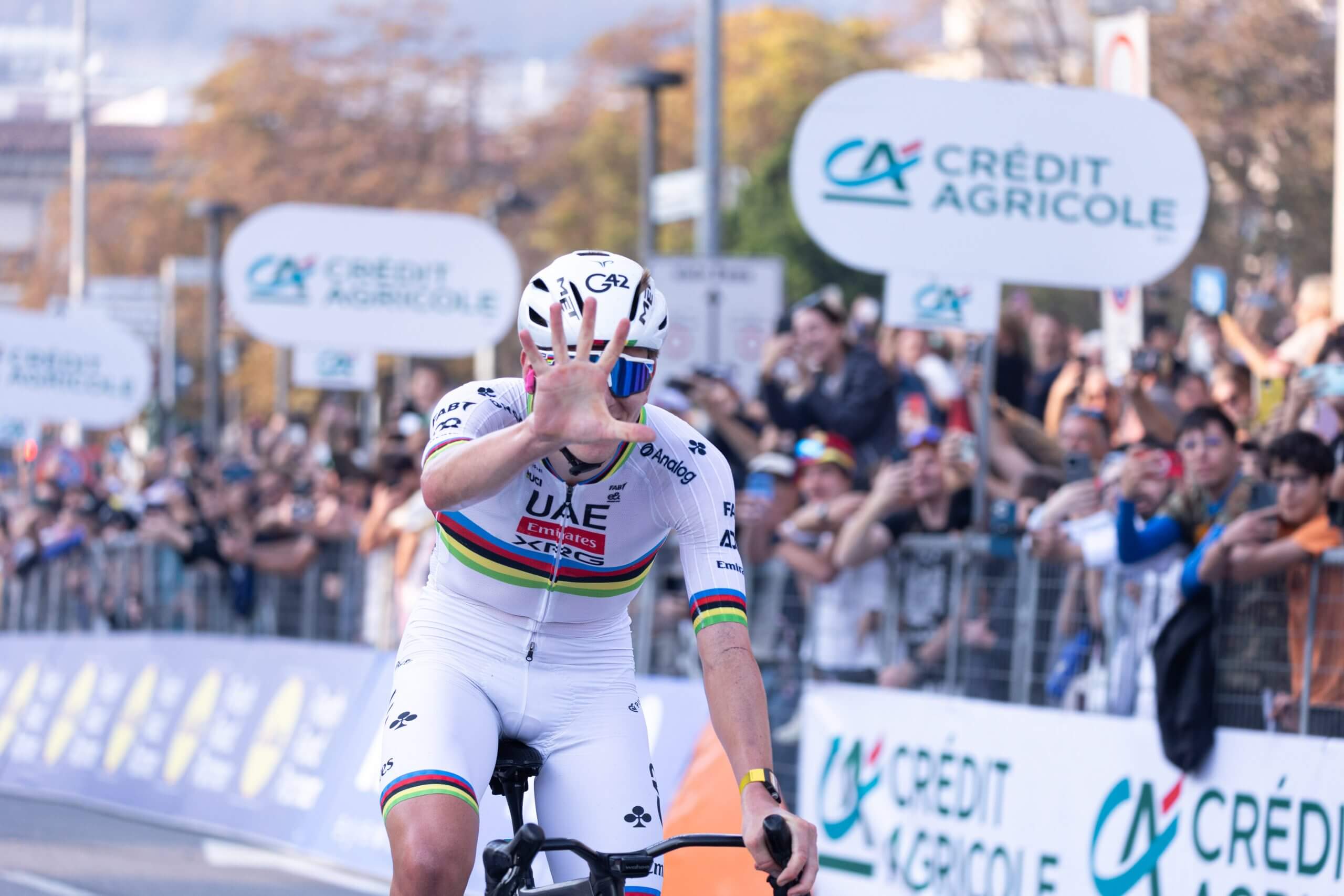
Pogacar celebrates becoming the first rider to win this race for five years in a row (Tommaso Berardi/NurPhoto via Getty Images).
Right now, Pogacar has three rivals — Van der Poel, Jonas Vingegaard, and apathy. He cut an exasperated and tired figure at the end of this year’s Tour de France, worn down by three weeks of racing, and, as he revealed this week, a knee injury that bothered him in the final week. One-day races, though, increasingly feel like his salve.
With Pogacar enjoying the Monuments more than any other events on the circuit, his dominance of the sport may sometimes be frustrating — but with the best rider in the sport embracing the history of these five legendary races, his pursuit of history in 2025 has provided them with a new lease of life.
Can he ever win Milan-San Remo or Paris-Roubaix? It is arguably the most intriguing question to ask of next season.

